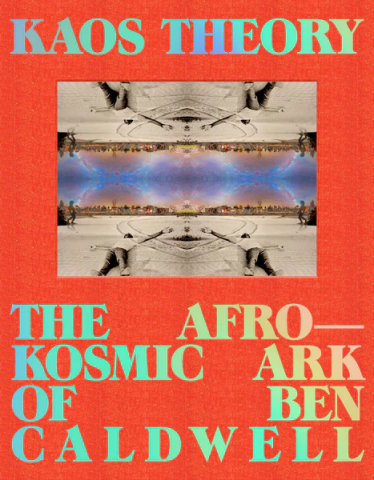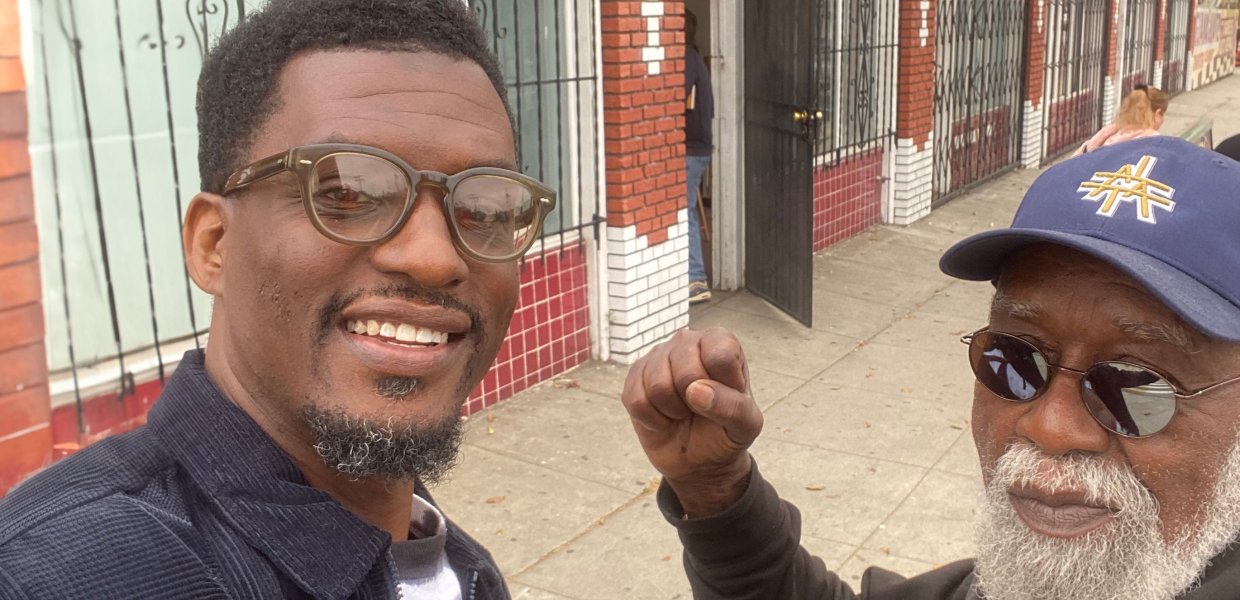Every Tuesday and Thursday for five months, Robeson Taj Frazier and Ben Caldwell met for a conversation.
Caldwell, an artist, filmmaker, and community organizer, founded the KAOS Network, a media arts center in Los Angeles' Leimert Park neighborhood. He initially sought out Frazier, associate professor of communication, for guidance on creating an archive. But, Frazier quickly realized what they were documenting together could be so much more.
“I asked him if he had ever thought about writing a book,” Frazier recalled. “And he asked me if I would be interested in writing a book. And I said, ‘I would love to write a book.’ So, we embarked on this intellectual, creative and collaborative journey.”

The result is KAOS Theory: The Afrokosmic Ark of Ben Caldwell (Angel City Press, 2023). Through vivid illustrations, archival media and engaging storytelling, the book weaves together Caldwell’s complex experiences from his childhood in New Mexico, his military service in Vietnam, his work as a filmmaker and pioneer of the L.A. Rebellion Film Movement, and as founder of KAOS Network.
Since the book’s release in October, Caldwell and Frazier have been giving talks together at bookstores and cultural spaces across the Southern California region, including Vroman's, Octavia's Bookshelf, Reparations Club and The Artform Studio. In the spring, they will extend their book tour to the Midwest and East Coast.
This month The New Yorker selected KAOS Theory as one of their favorite books of 2023. It’s also a finalist for the California Independent Booksellers Alliance’s Glenn Goldman Award: California Lifestyle.
“Caldwell’s restlessness of spirit is mimicked in the book’s elaborate, frenetic design,” writes Hua Hsu in The New Yorker. “It is one of the most beautiful objects I held in my hands this year, a coffee-table book as much as a rigorous monograph, full of archival images, photographs, flyers, and documents telling the story of Caldwell’s life.”
In addition to being highlighted in a recent episode of PBS SoCal | KCET’s Artbound, KAOS Theory has also been featured in publications such as Hyperallergic, the Orange County Register, Spectrum News 1, the Los Angeles Sentinel, and LA Weekly.
We spoke with Frazier about his new book and the journey he and Caldwell have shared creating it.
Can you explain chaos theory and how it connects with Ben Caldwell’s KAOS network and approach?
Chaos theory is a branch of mathematics that deals with complex and dynamical systems whose behavior is highly sensitive to slight changes in conditions so that small alterations can give rise to strikingly great consequences. It's a scientific theory that states that within the apparent randomness of chaotic complex systems, there are underlying patterns, interconnectedness, constant feedback, loops and repetition.
For Ben, art at its most simple and grandest form is what we call life. It’s the other species that surround us. It’s nature. It’s the environment. It’s human expression and its complexity. So, for Ben, art is anywhere and everywhere, all at once.
Chaos theory, in many ways, provided Ben with a western way of describing the patterns of love, community and stewardship that he believes are central to life and human coexistence. And it is a way of framing the creative practice that he has cultivated for himself and for others in his community.
Tell us about the book’s format and how you arrived at a more unconventional approach to its design.
For this project, we spent a lot of time with his family, with his friends, with his collaborators really diving into an archive that would cultivate a greater understanding of the history of the American Southwest, the Vietnam War, independent filmmaking, film cultures of the ’70s, ’80s and ’90s, hip hop, and Los Angeles.
Early on we knew that we wanted to create a book that was rich in terms of its narrative history and ideas, but also in incorporating art, film and media into its storytelling practice. It wasn't simply placing ‘stuff’ at the center of the book or as supplemental material, but being part of the reader's experience of engaging with the book. We wanted to make a work that was beautiful to look at and to engage with. Above all, we wanted to make a work that was a tribute to this kind of collective imagination, of collective endurance and of community building.
The book is in many ways a fusion of an artist monograph with biography, cultural history and an art catalog. But we haven't privileged any of those forms. We've tried to create something in which the reader can enter into it at different points. So, you might open the book and be drawn initially to an image or to a QR code that allows you to watch films or videos.
And how did this also figure into the book’s title?
Each chapter is about a different group of people. Ben is the node that connects all them, but we kind of trick people by using Ben's name on the cover. The book’s subtitle — The Afrokosmic Ark of Ben Caldwell — really describes all of the people who have helped to cultivate this ark of Black life. And when we say ‘ark,’ we mean the biblical ‘ark,’ a vessel you build to sustain yourself, to endure. And we also mean the ‘arc’ of history and how we get from one point to the next.
The other arc concept we incorporated is linked with film projectors, whose arc lamps produce an electric spark that allows us to see visual images on the screen. The idea is that the people in the communities that we talk about in the book are these arcs. They are the electricity that produces new possibilities, new points of connection, new experiences. And it's really the stewarding of those sparks. the lighting of those sparks, that is necessary in order for us to sustain ourselves, to sustain our communities and to build new ones.
What do you hope is the impact of sharing Ben’s story?
I believe the impact of sharing history is to give us a greater understanding of how we've gotten to the historical social points of life where we currently find ourselves. It gives us a better way of understanding the foundation upon which we stand. But I also think it’s not just about looking back, it’s about giving us the tools to think about the current day and as well as to activate our investment in tomorrow. We don't have to feel alone in trying to envision or imagine what to do. We can actually learn what they did and how they did it and why they did it, and who they did it with. So we can learn that the instruments we need are right around us, and the people we need to play those instruments with are potentially right around us.
I think Ben is extremely interested in asking not just what’s next, but how do we use what’s next in ways that tap into ancient ancestral traditions and practices. How do we use what is next and cultivate what is next so it can be used for good, for love, for understanding, and for empathy and solidarity?
Emily Cavalcanti and Olivia Mowry contributed to this report.
